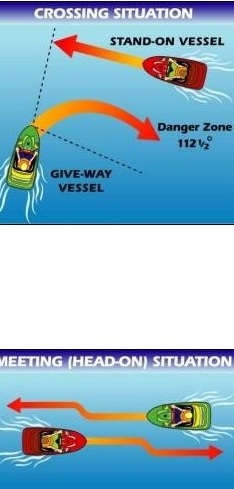Boating in SW Florida - Keep It Safe - Part 1 - Right-of-Way Issue is Often the Cause of Boating Accidents
January 16, 2015 | Category: Boating Accidents | Share
"Because we are in one of the busiest seasons for boating in Southwest Florida, and Lee and Collier Counties rank in the top ten counties with the most boating accidents, we at Spivey Law Firm, Personal Injury Attorneys, feel it is important to devote some time to the issue of boating right-of-way, navigation aids for boaters, and BUI (boating under the influence). We will present these three topics over the next few weeks as Part 1, Part 2, and Part 3 of 'Boating in Southwest Florida - Keep It Safe'," said Southwest Florida boater/fisherman and Florida Boating Accident Attorney, Randall Spivey of Spivey Law Firm Personal Injury Attorneys, P.A.
There are an estimated 20 million recreational boats in the United States, according to the U.S. Coast Guard. National statistics show there are about 7,000 boating accidents reported each year, resulting in 800 fatalities. Boaters need to understand the causes of small craft accidents, injuries, and fatalities in order to help prevent them.
In 2013 Florida continued to lead the nation in the total number of registered boats at 896,632. Florida also had 736 reportable boating accidents in the same year. Lee County ranked 6th, and Collier County ranked 9th. (Source: Florida Fish and Wildlife Commission)
When a boat is heading for you on a collision course, what do you do? Many boaters are unfamiliar with the rules of right-of-way, and accidents can are the result. It is the responsibility of operators to take the action needed to avoid collisions.
Even though no vessel technically has the “right-of-way” over another vessel, there are some rules that every operator should follow when encountering other vessels. The U.S. Coast Guard answers the question of "right-of-way" in the following way:
The Navigation Rules convey a right-of-way only in one particular circumstance: to power-driven vessels proceeding down-bound with a following current in narrow channels or fairways of the Great Lakes , Western Rivers, or other waters specified by regulation (Inland Rule 9(a)(ii)). Otherwise, power-driven vessels are to keep out of the way (Rule 18) and either give-way (Rule 16) or stand-on (Rule 17) to vessels not under command or restricted in their ability to maneuver, sailing vessels or vessels engaged in fishing, and, similarly vessels should avoid impeding the safe passage of a vessel constrained by her draft (Rule 18), navigating a narrow channel (Rule 9) or traffic separation scheme (Rule 10).
The Rules do not grant privileges. They impose responsibilities and require precaution under all conditions and circumstances. No rule exonerates any vessel from the consequences of neglect (Rule 2). Neglect, among other things, could be not maintaining a proper look-out (Rule 5), use of improper speed (Rule 6), not taking the appropriate actions to determine and avoid collision (Rule 7 & 8) or completely ignoring responsibilities under the Rules.
Should right-of-way be an issue, the TVA (Tennessee Valley Authority) "Rules of the Road for Recreational Boaters" say the following is the priority:
- Vessels being passed by other vessels
- Commercial tows and other vessels restricted in maneuverability
- Sailing or non-powered vessels
- Power-driven vessels not restricted in maneuverability
- Seaplanes.
The issues of Overtaking, Passing, and Crossing are also important to address here:
Overtaking
When Overtaking Another Boat: The boat being overtaken is considered the privileged vessel. Only after signaling and receiving an acknowledgment can the overtaking boat pass. (Use one blast to pass on the right, and two blasts to pass on the left.
When Being Overtaken:The lead boat, which always has the right-of-way, is to stay on your side of the channel and maintain a steady speed so that the overtaking vessel can pass safely. Use your radio, if you have one, to discuss this with the passing boat. (Although VHF radios are not currently required for small recreational boats, safe boating experts agree that they should be extremely high on a boater's safety equipment list.)
Passing
Like driving a car, when two power boat (including sailboats under power) approach one another from opposite directions (head-on), just as driving a vehicle, pass on the right-hand side. Nautically speaking, the port side of your boat will pass the port side of the other boat, or port-to-port. Each boat must give-way and alter its course or rate of speed to safety pass. (Source: Gosailing.info)
Crossing
International and Inland Rules state that when two power-driven vessels are crossing so as to involve the risk of a collision, the vessel which has the other on her starboard side (the give-way vessel) must keep out of the way.
As the give-way vessel it is your duty to avoid a collision. Typically, this means you must alter speed or direction to cross behind the other vessel (the stand-on vessel).
At night, if you see a red light crossing right-to-left in front of you, you need to change your course. If you see a green light crossing from left-to-right, you are the stand-on vessel, and should maintain course and speed. (Source: Boatus.org)
Want to prevent collisions while at sea? Experts recommend practicing good seamanship, keeping a sharp lookout, and maintaining a safe speed and distance.
Fort Myers Boating Accident Attorney, Randall L. Spivey is a Board Certified Trial Attorney – the highest recognition for competence bestowed by the Florida Bar and a distinction earned by just one (1%) percent of Florida attorneys. He has handled over 2,000 personal injury and wrongful death cases throughout Florida. For a free and confidential consultation to discuss your legal rights, contact the Spivey Law Firm, Personal Injury Attorneys, P.A., in Lee County at 239.337.7483 or toll free at 1.888.477.4839,or by email to Randall@SpiveyLaw.com. Visit SpiveyLaw.com for more information. You can contact Spivey Law Firm, Personal Injury Attorneys, P.A.in Charlotte County at 941.764.7748 and in Collier County 239.793.7748.

